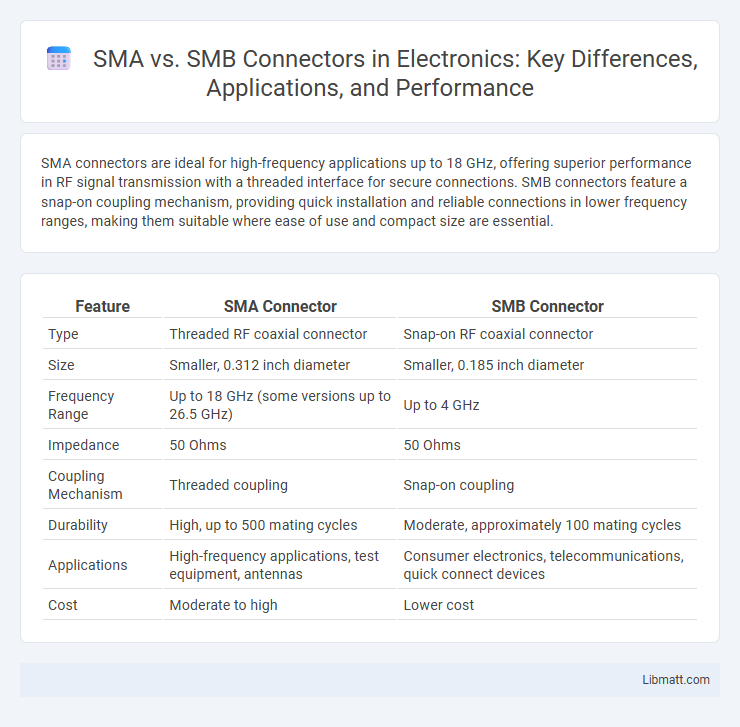SMA connectors are ideal for high-frequency applications up to 18 GHz, offering superior performance in RF signal transmission with a threaded interface for secure connections. SMB connectors feature a snap-on coupling mechanism, providing quick installation and reliable connections in lower frequency ranges, making them suitable where ease of use and compact size are essential.
Table of Comparison
| Feature | SMA Connector | SMB Connector |
|---|---|---|
| Type | Threaded RF coaxial connector | Snap-on RF coaxial connector |
| Size | Smaller, 0.312 inch diameter | Smaller, 0.185 inch diameter |
| Frequency Range | Up to 18 GHz (some versions up to 26.5 GHz) | Up to 4 GHz |
| Impedance | 50 Ohms | 50 Ohms |
| Coupling Mechanism | Threaded coupling | Snap-on coupling |
| Durability | High, up to 500 mating cycles | Moderate, approximately 100 mating cycles |
| Applications | High-frequency applications, test equipment, antennas | Consumer electronics, telecommunications, quick connect devices |
| Cost | Moderate to high | Lower cost |
Introduction: Understanding RF Connectors
SMA and SMB connectors are essential RF connectors designed for different frequency ranges and applications, with SMA supporting frequencies up to 18 GHz and SMB typically used up to 4 GHz. SMA connectors provide threaded coupling for secure, high-performance connections in microwave systems, while SMB connectors feature snap-on coupling for quick, reliable connections in compact RF devices. Understanding the distinct mechanical designs, frequency capabilities, and application suitability of SMA versus SMB connectors is crucial for optimizing signal integrity and system performance in RF communication systems.
Overview of SMA and SMB Connectors
SMA connectors are precision, threaded RF connectors designed for high-frequency applications up to 18 GHz, offering excellent mechanical stability and low insertion loss. SMB connectors feature a snap-on coupling mechanism for quick connections and are typically used in frequencies up to 4 GHz, providing ease of use in compact devices. Understanding the differences in size, frequency range, and coupling style helps you select the right connector for your RF and microwave signal transmission needs.
Design and Construction Differences
SMA connectors feature a threaded interface providing a secure, vibration-resistant connection ideal for high-frequency RF applications, while SMB connectors use a snap-on coupling mechanism designed for quick and easy mating with moderate retention force. SMA connectors typically have a more robust metal housing and precision-machined threads, enhancing durability and ensuring minimal signal loss at frequencies up to 18 GHz or higher. SMB connectors, with their compact size and simplified assembly, prioritize convenience and space-saving designs but generally support lower frequency ranges, typically up to 4 GHz.
Frequency Range and Performance
SMA connectors support frequencies up to 18 GHz, making them ideal for high-frequency applications such as RF and microwave communications, while SMB connectors typically operate efficiently up to 4 GHz, suitable for lower-frequency signal transmissions. The precision threading and stable impedance of SMA connectors ensure superior performance in minimizing signal loss and maintaining consistent transmission quality at high frequencies. Your choice between SMA and SMB should consider the required frequency range and performance demands of your specific application to achieve optimal signal integrity.
Applications of SMA Connectors
SMA connectors are widely used in high-frequency applications such as RF and microwave systems, including antennas, GPS devices, and cellular equipment, due to their excellent performance up to 18 GHz and robust threaded coupling mechanism. They provide reliable connections in precision instruments, aerospace, and military communication systems where signal integrity and durability are critical. Compared to SMB connectors, SMA connectors are preferred for permanent installations requiring stable, vibration-resistant connections in demanding environments.
Applications of SMB Connectors
SMB connectors are widely utilized in applications requiring quick connect and disconnect capabilities such as test equipment, telecommunications, and RF modules in wireless devices. These connectors provide excellent performance in frequencies up to 4 GHz, making them ideal for compact and mobile communication systems. Their snap-on coupling mechanism ensures reliable signal integrity and easy handling in high-density environments.
Mechanical and Electrical Characteristics
SMA connectors provide excellent mechanical stability with threaded coupling ensuring secure connections, while SMB connectors use a snap-on mechanism offering quick and easy mating. Electrically, SMA connectors handle higher frequencies up to 18 GHz with low signal loss, making them suitable for precision RF applications, whereas SMB connectors typically operate up to 4 GHz with moderate insertion loss. Your choice depends on the required frequency range and mechanical robustness in your RF system design.
Advantages and Disadvantages of SMA
SMA connectors offer excellent performance at microwave frequencies up to 18 GHz, making them ideal for high-frequency signal transmission with low return loss and stable phase characteristics. Their compact size and threaded coupling ensure reliable, vibration-resistant connections, but the installation can be time-consuming and requires proper torque to avoid damage or signal degradation. You benefit from SMA connectors in applications demanding durability and precision, though they are generally more expensive and less flexible than SMB connectors, which rely on snap-on coupling for quicker, lower-frequency use.
Advantages and Disadvantages of SMB
SMB connectors offer advantages such as a smaller size and quick snap-on coupling, making them ideal for space-constrained applications and rapid installations. However, SMB connectors typically have higher insertion loss and lower power handling compared to SMA connectors, which may limit their use in high-frequency or high-power scenarios. Their lower durability and less secure connection make them less suitable for environments requiring robust mechanical stability.
Choosing Between SMA and SMB: Key Considerations
Choosing between SMA and SMB connectors depends primarily on the application's frequency range and size constraints. SMA connectors offer superior performance up to 18 GHz, making them ideal for high-frequency RF applications, while SMB connectors provide a smaller form factor with quick snap-on coupling suitable for compact devices and moderate frequencies up to 4 GHz. Consider factors such as installation space, mating cycles, and mechanical durability when selecting the appropriate connector for optimal signal integrity and system reliability.
SMA vs SMB Connector Infographic

 libmatt.com
libmatt.com